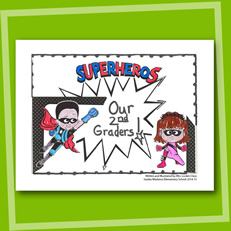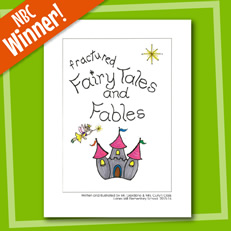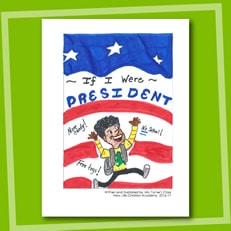
Check out these prompts to get your students’ creative juices flowing!
3rd Grade Narrative Writing Prompts that Encourage Great Storytelling and Creativity
Help your students go from an idea to a paragraph to a fully realized story with these narrative writing activities. These prompts are sure to engage your students and get them thinking outside the box.
In addition to practicing writing, prompts like this presents the perfect opportunity to create a classbook. If you take the writing exercises and include student’s illustrations of their narratives, you have what you need to create a classbook that tells a great story!
Writing Prompt #1: You have invented a time machine. Tell me when and where you went and what happened.
The time machine narrative is a great way to engage your students in imaginative thinking as well as a little bit of history. Before your students work with this prompt, have them do a brainstorming session where they answer the following questions:
- Which period of history haveyou always been interested in? (For example, prehistoric, the dark ages, etc.)
- If you could travel to any place in the world, where would you go? It can be somewhere you’ve already been or someplace new.
- Would you rather go into the past or the future? Why?
- If you could use three words to describe your time machine journey, what would they be?
Having your students take a moment to brainstorm before they jump into the writing will give them a chance to organize their thoughts and figure out what story they want to tell.
PROJECT IDEA
Once your students have developed their writing ideas, have them do a bit of research on the time period they have chosen if it is in the past or write down several ideas on what they think the future would be like. After your students organize their ideas and complete their piece of writing, have them do an illustration of what their time machine and journey would look like. This is a great way to memorialize every students’ story and showcase their imagination and narrative skills in a time traveling classbook.
Writing Prompt #2: You are a hero. What happened the day you became a hero?
This 3rd grade narrative prompt is a great way to get your students thinking about action and plot, two key components of storytelling. Plus, students get to imagine themselves as a hero and foster empathy as they create a scenario where they help others.
Before you have students jump into this prompt, it’s a great idea to have them create an outline of the actions that they think would happen if they became a hero. Introduce them to the narrative storytelling arc that will help them understand how a beginning, a middle, and an end functions. Then have them fill out worksheets to brainstorm what the arc of their story will look like, and what actions or plot points will occur along the way.
Having this outline will help them see the value in planning ahead and walk them through the process of writing that starts at brainstorming and ends with a full-length, cohesive story and complete the writing portion of the project.
PROJECT IDEA
Your students have spent a great deal of time thinking and writing about what they would do as a hero, why not have them imagine what they would look like as a hero? Have your students draw and design their own hero costumes. This is a great way for them to think about how they can illustrate specific details about their hero’s actions that they’ve already included in their narrative. Then, publish their work into a very heroic classbook.
Are you Enjoying this Content?
Writing Prompt #3: What would a typical day be like if you were 9 feet tall? What would you do?
When writing about what would happen when you’re nine-feet tall, there’s a good chance some conflict is going to emerge like not being able to fit through doors or into your normal clothes.
This 3rd grade narrative writing prompt helps students put their feet in another person’s shoes and think about how conflict and resolution plays a part in narrative storytelling. Before your students dive into this narrative prompt, take the time to help them understand what a conflict is and why it’s important to telling a story. Then have them sit down and think about the questions below:
- What is the central conflict in your story? What happens that goes wrong?
- How is this conflict resolved? What happens to fix the thing that goes wrong?
- What events or scenes happen in your story that show this conflict and resolution?
- Is the ending to your story happy or sad? Or both?
Giving your students this 3rd grade narrative writing prompt to help them understand and learn an important skill in narrative storytelling that will translate and stay with them as they grow as writers.
PROJECT IDEA
Have your students illustrate what a day in the life of a 9-foot tall version of themselves would look like. Take a blank piece of paper and divide it into separate panels. Then have them draw out the scenes of their narrative, this will help them write their story and give them a picture to go with their narrative. This project idea is a great way to help your students visualize the conflict and scenes they created and show them another way that storytelling is possible. Gather all your student’s writing and illustrations and create a classbook to showcase your students’ work!
Writing Prompt #4: Imagine that you are the main character from your favorite book. Who would you be? Write about the adventures you would have.
By having your students imagine that they are the main character from their favorite book, they’re encouraged to use their creativity and storytelling skills in a narrative that they feel connected to and familiar with. This prompt is also a great way to allow your students to employ some descriptive adjectives. Descriptive words and details are what makes any story enjoyable and engaging to read. By using the assignment requirements below as a guide, your students can practice making their writing more descriptive and detail-oriented.
Assignment requirements:
- Use descriptive vocabulary (describe what the character looks like, how they are feeling, what they are doing, etc). Use this worksheet to provide unique verbs and adjectives to your students.
- Build a setting for your character, either using the book, your own imagination, or both.
- Include details from the book, but don’t be afraid to come up with your own original adventures as well!
PROJECT IDEA
Have students close their eyes and visualize themselves as the main character of their favorite book. After they open their eyes, have them write down what they saw. This will help them develop their story beyond just changing the name of the main character in their favorite book. After the writing is complete, your students can draw the cover of their new book and pair that with their writing to contribute to your class’ collection of reimagined stories! If you want to get a little more writing practice in, you can have them rewrite the book jacket or description of the book as well! Then collect all the book covers and jackets to create a classbook!
Writing Prompt #5: Write about a time you were lost or thought you were lost. What happened? How did you figure out where you were?
When writing a cohesive and organized story, it’s important to think about things like the sequence of events and transitions. This writing prompt encourages your students to think about the order of the events that they are writing about and how they can organize them in a logical and engaging way.
First, have your students take a trip down memory lane and think about a time they were lost or thought they might be lost. It is a good idea to create a mind map at this stage of the writing process. Have your students think of words and phrases that they associate with this event in their life of getting lost. And if they can’t come up with a time they’ve gotten lost, encourage them to think of a time that someone else got lost or create an imaginary event.
A mind map can help students remember details like setting, how they were feeling, and what exactly happened better through word association.
PROJECT IDEA
Armed with their memories, students can then begin to write out the sequence of events that happened. It might be helpful for students to make a list of events in the order they happened, and then go back to flesh out their list into a more formal narrative. Your students have already created a map of their experience with words, now let them create a visual map! Start by showing your students examples of maps from amusement parks or zoos so they can see how you can incorporate images and text to create a map to guide them through the time when they got lost. Collect these maps put your students’ hard work into a published classbook when they’re finished!
Writing Prompt #6: If you could be any person in history, who would you be? Imagine what a day in the life of that person would be like and describe what you would do.
Storytelling isn’t always just about creativity and imagination, although those are two very important parts of narrative writing. A lot of narrative writing involves research in one form or another. Having your students consider a person in history that they would like to be in their shoes for a day is a great way to encourage research and bridge the gap between academic research and creative writing.
First have your students choose the person in history they want to spend some time with. Then encourage them to look up facts about this person, what they were like, why they were famous, what they did, where they lived, the time period they lived in, etc. Sources such as textbooks and scholastic databases might be helpful in giving your students the information they need.
Once your students have a well-rounded idea of who this person is, they can start to get creative. Encourage them to take risks and stray from the narrative of this person’s life and think about what they would do if they were that person. All the while, ensure that your students are using the basic techniques of narrative writing such as descriptive language, setting, scene building and organization.
PROJECT IDEA
A fun project idea that you can do with your students after they complete this narrative writing prompt is to put together a biography of their chosen historical figure. First, have them gather their research, including any photographs and facts, and outline a short biography for their chosen person. Once they’re finished, then have them create a second biography using the information in their outline that showcases what this person’s life would look like if the student were living it. This project gives students a chance to reflect on their research, incorporate their narrative prompt, and is a great way to create an informative and fun classbook to share with everyone!
Narrative writing is a vital skill for students to learn and one that will stick with them throughout their academic career and beyond. It’s an opportunity for students to understand what makes a story great and how to tell one themselves. It also allows for the merging of creativity and research. All of these prompts and projects are great opportunities to create a classbook to showcase your students’ work and preserve their stories!
Additional resources:
Our online teacher’s lounge is an excellent place for you to find more suggestions on ways to improve your students’ writing. Head over to sign up and receive a free classbook publishing kit to make a special memory for your class.








